ExxonMobil Chemical
Alkylated Naphthalene Basestocks Advance High-Performance Lubricants
By Sandra Mazzo-Skalski, Performance Product Specialist, ExxonMobil Chemical | TLT CMF Plus November 2009
]
Automotive trends including increased fuel economy, lower oil volumes and reduced drain intervals are driving lube requirements toward better basestocks. Synthetic fluids such as ExxonMobil’s Synesstic™ Alkylated Naphthalene (AN) Blendstocks enable formulators to meet these increasingly stringent demands.
Synesstic AN delivers improved oxidation performance for automotive engine oils as well as compressor fluids while offering enhanced deposit protection and increased wear protection through additive effectiveness. Recent testing also reveals that Synesstic AN improves wear, high-temperature life and thickening efficiency in greases.
Synesstic AN Blendstock Basics
Alkylated naphthalenes, an API Group V fluid, are aromatic fluids consisting of a naphthalene molecule and an alkyl side chain. This report focuses on the 5 cSt and 12 cSt grades of Synesstic AN. (
Figure 1.)
 Figure 1.
Figure 1.
Synesstic AN is a pure hydrocarbon material that does not have any ester linkages and contains an aromatic group, offering the potential stability of a PAO (hydrocarbon) and the solubility effects of an ester (aromatic rings).
These characteristics make Synesstic AN particularly well-suited for use as a blendstock in synthetic lubricant applications that require high stability under extreme operating conditions.
Proven Capabilities
The Rotary Pressure Vessel Oxidation Test (RPVOT), used to measure the oxidation resistance of oils for industrial applications, demonstrates the advantages of Synesstic AN. (
Figure 2.)
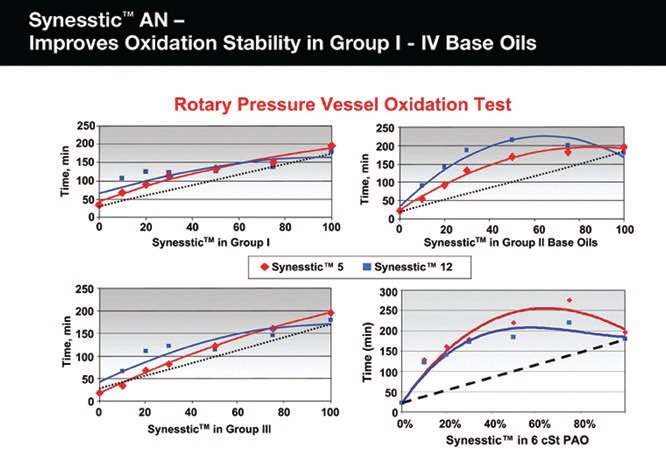 Figure 2.
Figure 2.
In a typical test of oxidation performance, adding a basestock with better oxidative stability would tend to show improvement in a proportional, straight-line relationship. Adding Synesstic AN to Group I, Group II, Group III or Group IV basestocks actually produces a synergistic effect, where a formulator would realize more benefit than expected based on the amount of basestock used. The end result is the ability to use less Synesstic AN and still achieve the maximum amount of oxidation improvement.
For engine oils, oxidation resistance can be measured with ExxonMobil’s Sequence III Screener test. (
Figure 3.) The oil sample is heated in the presence of a catalyst and flowing air with the viscosity measured at approximately 24-hour intervals.
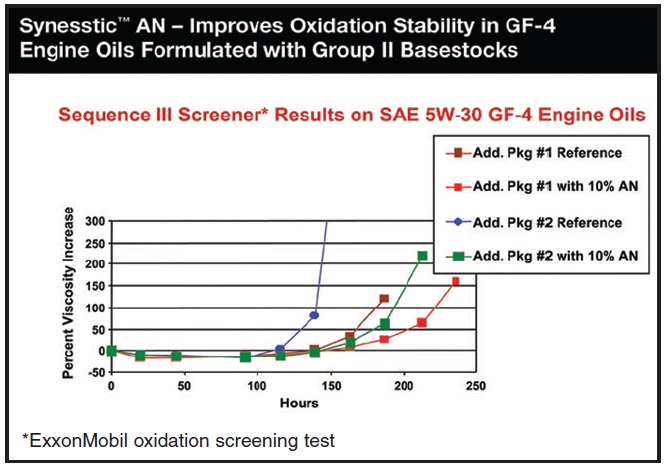 Figure 3.
Figure 3.
The test is generally run until the sample has reached a doubling of viscosity. In the example shown, two sets of GF-4 engine oils with different additive chemistries are test-blended with Group II basestocks and 10 percent Synesstic AN. The results show that adding just 10 percent Synesstic AN significantly improves the oxidation performance of a fully formulated GF-4 engine oil blended with Group II basestocks.
Tests were also conducted with 5W-30 GF-4 engine oils blended with Group III basestocks in the Sequence III Screener. Frequently, Group V basestocks are added to help improve performance and enhance additive solubility (in this instance, 10 percent ester and 10 percent Synesstic AN). While the ester/ Group III blend performed similarly to the all-Group III blend, the Group III/Synesstic AN blend demonstrated improved oxidative stability.
Enhanced Additive Effectiveness
As the trend toward lower-viscosity oils for fuel economy and lower phosphorus levels for emissions reduction puts pressure on wear protection performance, the greater level of additive effectiveness that can be achieved by Synesstic AN becomes more critical.
In a direct comparison between PAO/ester and PAO/Synesstic AN blends, one distinguishing characteristic is that ester molecules are polar and thus more attracted to metal surfaces. The problem is that additive molecules are also attracted to the surface, creating a competition for space on the metal surface. When this occurs, additive performance capabilities may not be fully realized. (
Figure 4.)
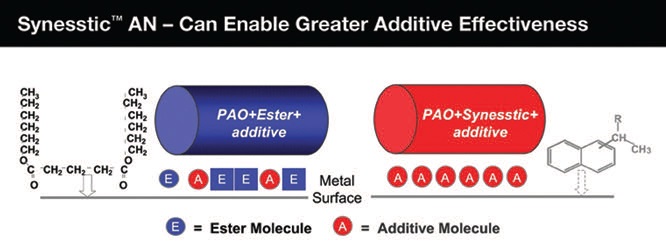 Figure 4.
Figure 4.
By replacing the ester with Synesstic AN, better surface protection can be achieved along with a potential cost benefit, as a reduced level of the additive package may deliver the same level of protection.
The polarity differences between Synesstic AN and ester are magnified in the case of low-phosphorus engine oils. (
Figure 5.) The lack of competition for the surface results in better wear performance for oils blended with PAO and Synesstic AN than those blended with PAO and ester. This effect was demonstrated by a Sequence IIIG engine test in which synthetic engine oils blended with PAO and Synesstic AN showed reduced cam and lifter wear.
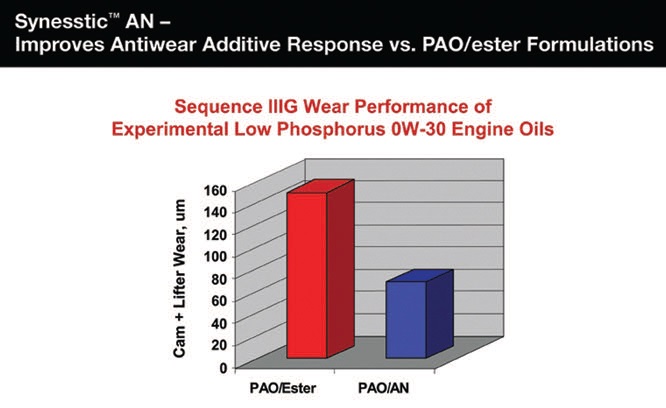 Figure 5.
Figure 5.
Other engine tests, simulating stop-and-go commuting conditions and heavy-duty diesel engine service, respectively, produced similar results. Synthetic engine oils blended with Synesstic AN and a PAO demonstrated improved wear performance versus ester/PAO formulations.
Greater Greases
New testing with Synesstic AN in grease formulations reveals additional performance capabilities. (
Figure 6.) An all-Synesstic AN 12 grease with a basestock viscosity of 100 cSt outperformed an all-PAO grease with a similar basestock viscosity in a fretting wear test, which assesses the ability to prevent wear in conditions where the motion is oscillatory. This is a key performance parameter on railcars and trucks.
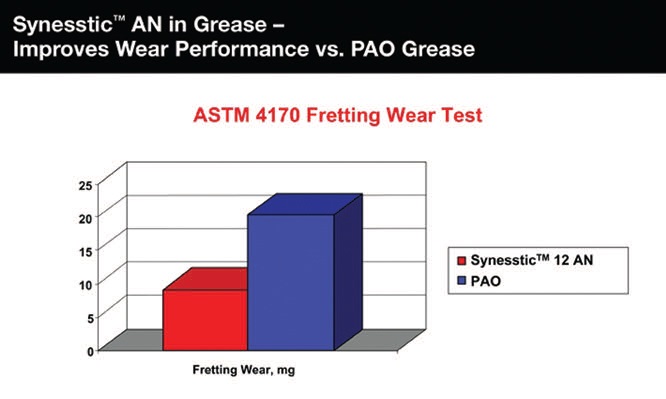 Figure 6.
Figure 6.
In a high-temperature test of grease life – in which a set of bearings is run to failure – a Synesstic AN grease showed significantly improved high-temperature life performance compared with an all-PAO grease.
Synesstic AN can also reduce the amount of thickener needed in grease production. Using less thickener can help improve low-temperature pumpability and make manufacturing easier. (
Figure 7.)
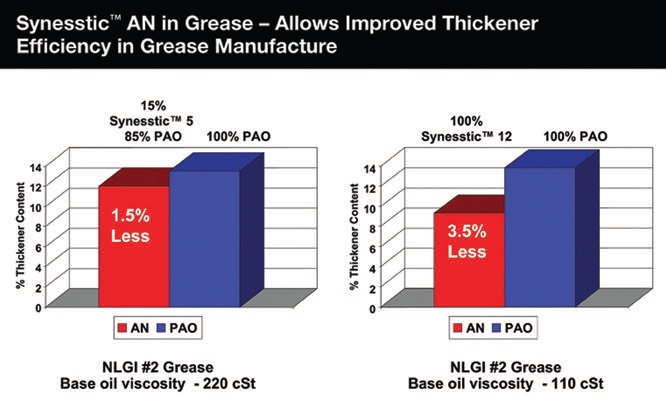 Figure 7.
Compressor Formulations
Figure 7.
Compressor Formulations
Extended drain capability is a major performance goal for compressor fluids, and Synesstic AN is able to improve the long-term oil stability of these formulations. In the Turbine Oil Stability Test (TOST), oils are exposed at an elevated temperature to moist air and copper and iron catalysts until a Total Acid Number (TAN) of 2.0 is reached. (
Figure 8.)
 Figure 8.
Figure 8.
A formulation of PAO and 10 percent polyol ester showed an increase in TAN as the test approached 2,000 hours, indicating the start of breaking down. A formulation of PAO and 10 percent Synesstic 5 showed almost no change in TAN, even beyond 2,000 hours.
For the consumer, the benefits of using Synesstic AN include reduced oil degradation (especially in wet operating environments), extended oil service life and reduced operating costs.
Summary
Synesstic AN blendstocks are Group V category fluids that deliver improved hydrolytic and thermo-oxidative stability compared with other Group V fluids. Synesstic products are used in applications ranging from lubricants for automotive engines and compressors to hydraulic fluids and high-temperature greases.
Visit
www.exxonmobilsynthetics.com for more information, as well as to download a Synthetic Lubricants Basestocks brochure.
©2009 Exxon Mobil Corporation. To the extent the user is entitled to disclose and distribute this document, the user may forward, distribute, and/or photocopy this copyrighted document only if unaltered and complete, including all of its headers, footers, disclaimers, and other information. You may not copy this document to a Web site. ExxonMobil does not guarantee the typical (or other) values. Analysis may be performed on representative samples and not the actual product shipped. The information in this document relates only to the named product or materials when not in combination with any other product or materials. We based the information on data believed to be reliable on the date compiled, but we do not represent, warrant, or otherwise guarantee, expressly or impliedly, the merchantability, fitness for a particular purpose, suitability, accuracy, reliability, or completeness of this information or the products, materials, or processes described. The user is solely responsible for all determinations regarding any use of material or product and any process in its territories of interest. We expressly disclaim liability for any loss, damage, or injury directly or indirectly suffered or incurred as a result of or related to anyone using or relying on any of the information in this document. There is no endorsement of any product or process, and we expressly disclaim any contrary implication. The terms “we,” “our,” “ExxonMobil Chemical,” or “ExxonMobil” are used for convenience, and may include any one or more ExxonMobil Chemical Company, ExxonMobil Corporation, or any affiliates they directly or indirectly steward. ExxonMobil, the ExxonMobil Emblem, the “Interlocking X” device and Synesstic are trademarks of Exxon Mobil Corporation.